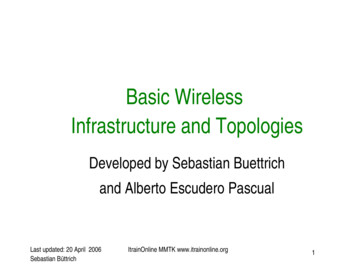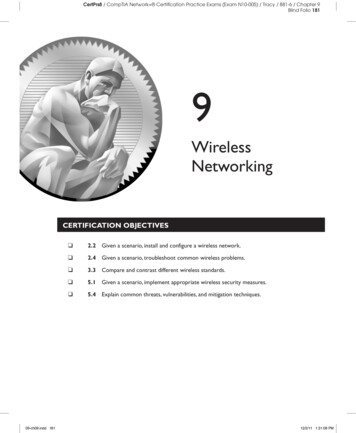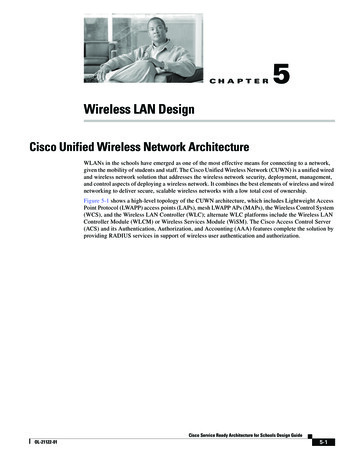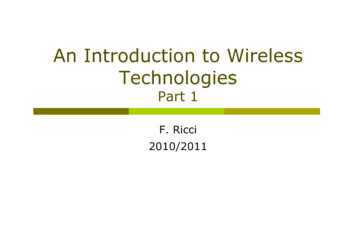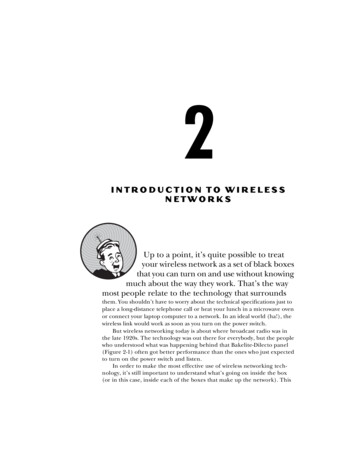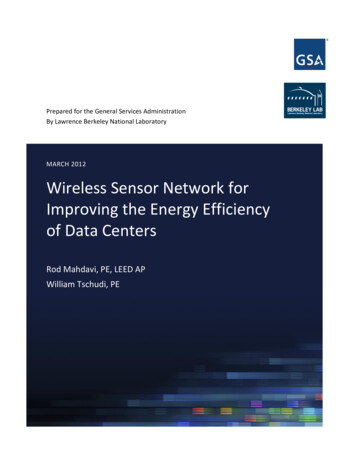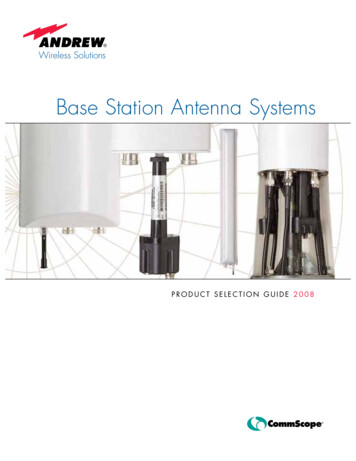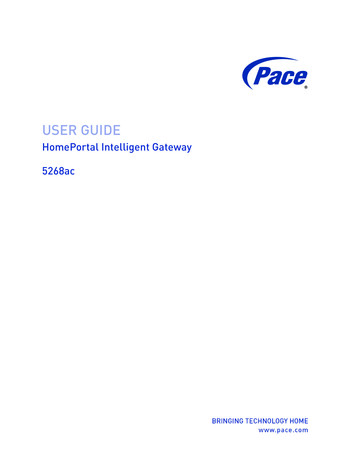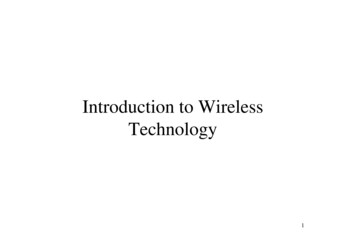
Transcription
Introduction to WirelessTechnology1
Introduction to wirelessTechnology Increasing number of mobile radio communicationsystems used in everyday life. Garage dooropeners, remote controllers for home entertainmentequipment, cordless telephones, hand-held walkietalkies, pagers, and cellular telephones are allexamples of mobile radio communication systems. However, the cost, complexity, performance, andtypes of services offered by each of these mobilesystems are decreasing.2
Introduction to wireless Technology The term wireless communication refers to thetransfer of information using electromagnetic(EM) or acoustic waves over the atmosphererather than using any propagation medium thatemploys wires. Not requiring an explicit networkof wires and permitting communication while onthe move Fortunately, EM waves travel with the speed of light infree space and inside medium (cables) – with adelay-time length of cable/C3This allows very fast communication.
EM waves can propagate in free spaceand inside different media Inside coaxial cables, the electric field is theradial direction between the inner and outerconductors, and the magnetic field formscircles around the inner conductors, bothperpendicuar to the direction of propagation(cable)4
Thus, in order to be able to design good wirelesssystems, it becomes imperative, to have a goodunderstanding of electromagnetic waves and thepropagation media used in conjunction to achievecommunication.This chapter will try to cover the following topics1 An introduction to the wireless systems anddifferent technologies,2 Characterization of the various frequency bands,3 Basic radio propagation theory5
Currently: Wireless technology is a fast growing onewith lots of exciting actions WLAN rapidly growingo 802.11b, 802.11a, g,. Wide area wireless data also growing Support for voice and data in 2.5G and 3Gwireless Wireless broadband Location-based services, WAP6
Current Wireless Systems Cellular SystemsWireless LANsWIMAXSatellite SystemsPaging SystemsBluetoothUltrawideband RadiosZigbee Radios7
8
9
10
11
12
13
14
15
Radio Spectrum Allocation andClassification16
17
Radio Spectrum Classification18
The radio spectrum is divided into sub-bands based on eachfrequency range's suitability for a given set of applications.Suitability is determined as a function of the atmosphericpropagation characteristics of the given frequencies as wellas system aspects, such as required antenna size andpower limitations. Based on these considerations, the radio spectrum has beendivided into the following sub bands:1) Extremely Low Frequency (ELF)300 - 3000 Hz (λ 1000 - 100 km)2) Very Low Frequency (VLF)3 - 30 kHz (λ 100 - 10 km)Propagation Characteristics: Propagates between thesurface of the Earth and the Ionosphere. Can penetratedeep underground and underwater. As the required antennasize is proportional to the wavelength, the large wavelengthin this case mandates the use of large antennas.Applications: underwater communication (submarines), 19SONAR
3) Low Frequency (LF)30 - 300 kHz (λ 10 - 1 km)Propagation Characteristics: The sky wave can be separatedfrom the ground wave for frequencies above 100 kHz. Thisenables communication over large distances by reflecting thesky wave off the atmosphere.Applications: broadcasting, radio navigation4) Medium Frequency (MF)300 - 3000 kHz (λ 1000 - 100 m)Propagation Characteristics: The sky wave separates fromthe ground wave in this range. Ground wave gives usablesignal strength up to 100 km from transmitter.Applications: AM radio broadcasting (550 - 1600 kHz)20
5) High Frequency (HF) 3 - 30 MHz (λ 100 - 10 m)Propagation Characteristics: The sky wave is the mainpropagation mode. The ground wave is used forcommunication over shorter distances than the sky wave. Aspropagation loss increases with frequency increase, the use ofrepeaters is required.Applications: Broadcasting over large areas, amateur radio,citizens band (CB) radio6) Very High Frequency (VHF) 30 - 300 MHz (λ 10 - 1 m)Propagation Characteristics: Diffraction (bending of waves dueto obstruction) and reflection give rise to communicationbeyond the horizon. Propagation distances are thousands ofkilometers. The diffraction and reflection enables receptionwithin buildings.Applications: broadcast TV, FM radio (88 - 108 MHz), radiobeacons for air traffic control21
7) Ultra High Frequency (UHF) 300 - 3000 MHz (λ 1 m - 10 cm)Propagation Characteristics: Reflections from atmosphericlayers are possible. Effects of rain and moisture arenegligible.Applications: broadcasting, satellite (TV) broadcasting, all (1Gto 3G) land mobile phones, cordless phones, some air trafficcontrol8) Super High Frequency (SHF) 3 - 30 GHz (λ 10 - 1 cm)Propagation Characteristics: Range becomes limited byobstacles as frequency increases. Propagation is limited byabsorption by rain and clouds.Applications: Satellite service for telephony and TV, mobileservices in the future22
9) Extremely High Frequency (EHF) 30 - 300 GHz (λ 10 - 1 mm)Propagation Characteristics: Very high lossesdue to water, oxygen, vapor.Applications: communications at shortdistances (within line of sight), broadcastsatellite for HDTV (for communicationbetween satellites in space, not space toearth)23
Summary: EM Spectrum24
25
26
Wireless Systems: Range Comparison:1mIR10 mBlueooth100 m1 KmWLANs10 KmMobileTelephony,WLL100 KmMWRadio1,000 KmSWRadioSatelliteLinks27
The Different Wireless systems:Standards:28
Wired vs. wireless communication:WiredEach cable is a different channelSignal attenuation is lowNo interferenceWirelessOne media (cable) shared by allHigh signal attenuationHigh interferenceWhy go wireless? --- Wirelss is mobilizing all servicesUsers want applications independent of access, device and locationAdvantages: Sometimes it is difficult to lay cables User mobility CostLimitations: Bandwidth Power (In)security29
AIM:Is to have an open mobile plateform for many multimedia services.30
The Cluttered World ofRadio alls31
EEPropagation in the“Real World”a wavecanbe absorbedpenetratereflectbend32
Radio PropagationThree basic propagation mechanismsReflectionDiffractionλ Dλ DScatteringλ D Propagation effects depend on not only on the specific portion ofspectrum used for transmission, but also on the bandwidth (orspectral occupancy) of the signal being transmitted Spatial separation of Tx-Rx33
Propagation Mechanisms:Propagation in free space is the ideal. Whenpropagation takes place close to obstacles, thefollowing propagation mechanisms occur:a) Reflection – Occurs when a radio wave strikes anobject with dimensions that are large relative to itswavelength, i.e. buildings.b) Diffraction – Occurs when a radio wave isobstructed by surfaces with irregularities.Secondarywaves arise from the obstructing surface and giverise to the bending of waves around and behindobstacles.c) Scattering – Occurs when a radio wave travelsthrough a medium containing lots of small34(compared to wavelength) objects.
Wave Propagation Problems: Path loss and attenuation on obstaclesReflection, diffraction, scatteringInterference (adjacent or co-channel)Thermal or man-made noiseImperfections of transmit / receive circuitry35
ATMOSPHERIC EFFECTS ON WIRELESS CHANNELSThe wireless medium introduces difficulties for communication by itsvery inherent nature. The atmosphere reflects, absorbs or scattersradio waves. The layers most relevant to terrestrial radio propagationare shown in fig 1 below.36
Evaluating Frequencies 50MHz- Good for range outdoors (antenna size,bending and penetrating), no foliage problems. “Sees”metallic building structures, doesn’t pass throughwindows or down corridors, needs large antenna (2meter). TV? 450 MHz to 2 GHz - Good compromise for cellulartype systems. Antenna small, but big enough foroutdoor range. Minor foliage effects. OK for windowswalls and corridors. (450 might be best, but .) (Rangeissue for 2 GHz systems- more bases) 5-20 GHz- Antenna too small for range. Foliage andrain effects. Indoor microcells? Point-to-point?Satellites to ground stations?Foliage losses are due to trees and forests.37
38
39
40
IEEE 802.11 Family:802.11 is a family of specifications for wireless local areanetworks (WLANs) developed by a working group of theInstitute of Electrical and Electronics Engineers (IEEE).Thereare currently four specifications in the family. 802.11e and802.11i are scheduled for approval.802.11802.11a802.11b802.11gAll four use the Ethernet protocol and CSMA/CA (carrier sensemultiple access with collision avoidance) for path sharing.41
IEEE 802.11 - applies to wireless LANs andprovides 1 or 2 Mbps transmission in the 2.4GHz band using either frequency hopping spreadspectrum (FHSS) or direct sequence spreadspectrum (DSSS).IEEE 802.11a - an extension to 802.11 that appliesto wireless LANs and provides up to 54 Mbps inthe 5GHz band; but most commonly,communications takes place at 6 Mbps, 12Mbps, or 24 Mbps. 802.11a uses an orthogonalfrequency division multiplexing encoding schemerather than FHSS or DSSS. The specificationapplies to wireless ATM systems and is used inaccess hubs.42
IEEE 802.11b - often called Wi-Fi - is backwardcompatible with 802.11. The modulation used in802.11 has historically been phase-shift keying(PSK). The modulation method selected for 802.11bis known as complementary code keying (CCK),which allows higher data speeds and is lesssusceptible to multipath-propagation interference.IEEE 802.11e - first wireless standard that spanshome and business environments. It adds qualityof-service (QoS) features and multimedia support tothe existing IEEE 802.11b and IEEE 802.11awireless standards, while maintaining full backwardcompatibility with these standards. QoS andmultimedia support are critical to wireless homenetworks where voice, video and audio will be 43delivered.
IEEE 802.11g - applies to wireless LANs and provides20 Mbps in the 2.4 GHz band.This is the most recently approved standard andoffers wireless transmission over relatively shortdistances at up to 54 megabits per second (Mbps)compared with the 11 megabits per second of the802.11b standard. Like 802.11b, 802.11g operates inthe 2.4 GHz range and is thus compatible with it.IEEE 802.11i - adds the Advanced EncryptionStandard (AES) security protocol to the 802.11standard for wireless LANs. Security has been aprimary concern for IT managers reluctant to deploywireless networks, but AES is a stronger level ofsecurity than found in the current Wi-Fi ProtectedAccess security standard.44
IEEE 802.15is a communications specification that wasapproved in early 2002 by the Institute ofElectrical and Electronics EngineersStandards Association (IEEE-SA) for wirelesspersonal area networks (WPANs). The initialversion, 802.15.1, was adapted from theBluetooth specification and is fully compatiblewith Bluetooth 1.1.45
IEEE 802.16802.16 is a group of broadband wirelesscommunications standards for metropolitan areanetworks (MANs) developed by a working group ofthe Institute of Electrical and Electronics Engineers(IEEE). The original 802.16 standard, published inDecember 2001, specified fixed point-to-multipointbroadband wireless systems operating in the 10-66GHz licensed spectrum. An amendment, 802.16a,approved in January 2003, specified non-line-ofsight extensions in the 2-11 GHz spectrum,delivering up to 70 Mbps at distances up to 31miles. Officially called the WirelessMAN specification, 802.16 standards are expected toenable multimedia applications with wirelessconnection and, with a range of up to 30 miles,46provide a viable last mile technology.
47
48
Mobile radio transmission systems may beclassified as simplex, half-duplex or full-duplex. In simplex systems, communication is possiblein only one direction. Paging systems, in whichmessages are received but not acknowledged,are simplex systems. Half-duplex radio systems allow two-waycommunication, but use the same radio channelfor both transmission and reception. This meansthat at any given time, a user can only transmitor receive information. Constraints like "pushto-talk" and "release-to-listen" are fundamentalfeatures of half-duplex systems.49
Full duplex systems, allow simultaneous radiotransmission and reception between asubscriber and a base station, by providing twosimultaneous but separate channels (frequencydivision duplex, or FDD) or adjacent time slotson a single radio channel (time division duplex,or TDD) for communication to and from theuser. FDD is used exclusively in analog mobile radiosystems50
Frequency division duplexing (FDD) providessimultaneous radio transmission channels for thesubscriber and the base station, so that they both mayconstantly transmit while simultaneously receiving signalsfrom one another. At the base station, separate transmit and receive antennasare used to accommodate the two separate channels. Atthe subscriber unit, however, a single antenna is used forboth transmission to and reception from the base station,and a device called a duplexer is used inside thesubscriber unit to enable the same antenna to be used forsimultaneous transmission and reception. To facilitate FDD, it is necessary to separate the transmitand receive frequencies by about 5% of the nominal RFfrequency, so that the duplexer can provide sufficientisolation while being inexpensively manufactured. 51
Time division duplexing (TDD) uses the fact thatit is possible to share a single radio channel intime, so that a portion of the time is used totransmit from the base station to the mobile, andthe remaining time is used to transmit from themobile to the base station. TDD is only possible with digital transmissionformats and digital modulation, and is verysensitive to timing.52
53
54
55
Introduction to wireless Technology The term wireless communication refers to the transfer of information using electromagnetic (EM) or acoustic waves over the atmosphere rather than using any propagation medium that employs wires. Not requiring an explicit networ

